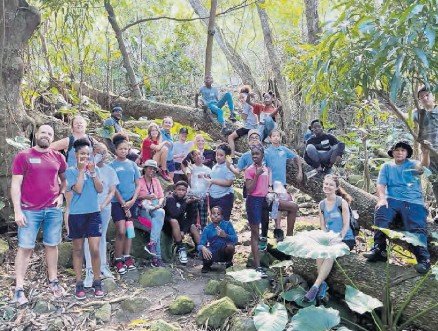Pupils ventured into the forest in Troy Hill to collect fallen seeds of the West Indian almond tree.
Last week, the grade six Science SEAkers of Sacred Heart School had the opportunity to participate in a reforestation activity by collecting and planting seeds of the West Indian almond tree.
The activity was organised by the Sea and Learn Foundation in partnership with the public entity Saba’s reforestation project as part of its education and awareness programme for the Nature and Environment Policy Plan.
The goal of this activity was to introduce pupils to the island’s flora using this particular tree species, inform them about the important role that trees play in our lives and in the prevention of erosion and explain to them why a reforestation project on Saba is necessary.

The pupils were first given a presentation about the West Indian almond tree by the reforestation project manager. They discovered that humans brought this tree from its native Asia to the region in the 19th century. Since then, the tree has become established as part of the local flora, with numerous trees growing in different locations on the island, including ‘Roy Hill, Over the Peak, English Quarter and lower Hell’s Gate. The pupils also learned about the tree’s physical characteristics,
which would assist them in recognising it while in the forest.
After the presentation, the pupils ventured into the forest in Troy Hill to collect fallen seeds of the West Indian almond tree. They were tasked with selecting only seeds that were ready to be planted; this meant that they had to differentiate between the various stages of growth and the drying out process of the seeds in order to determine which seeds were ready to be planted and which were not.
Only the seeds of which the outer flesh had been removed and with endocarps (the outer shell of the pit) exposed were to be collected. While in the forest, the pupils also had the opportunity to see how invasive animal species can negatively impact native and naturalised plants on the island. At the base of one of the trees was the home of a rat, that had collected most of the fallen seeds and eaten them. Because of this, very few seeds had been able to germinate.
Upon returning to the classroom, the pupils were guided by reforestation ranger Dwayne McKenzie on how to plant the seeds using soil and pots provided by the reforestation project. Each pupil planted a seed and labelled their pot with the tree species, date of planting and their own name. The pupils will now care for the seeds and any young trees that grow from them until the end of the school year.
Eventually, the young trees will be returned to the reforestation project and planted at one of the reforestation sites that will be developed in the future.
The Daily Herald.
 Saba News News and Information from Saba Island, Dutch Caribbean
Saba News News and Information from Saba Island, Dutch Caribbean
